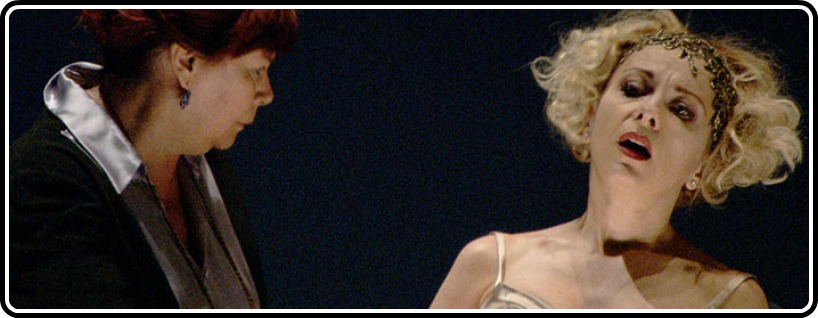A rather common topic for films fiction and non-fiction alike, the creative process has always been a topic that has thrilled and enthralled audiences throughout the history of film. Be it the idea of a film being directly about the crafting of a piece of cinema, or ideas a tad more experimental and esoteric, creativity and the fuel behind it has been the central topic of some of film’s most intriguing pieces.
Becoming Traviata is not quite the classic of the genre that its legendary source material would imply, but it’s a truly superb look at just that very process, in one of the more surprising documentaries you’ll see this very year.
From director Philippe Beziat, this documentary takes a Wiseman-like look at Natalie Dessay, and her preparation in the lead up to her starring role in a new staging of the legendary Verdi masterpiece set for the Aix-en-Provence Festival in France. La traviata was first performed in 1853, and is an opera that finds its inspiration in a novel from writer Alexandre Dumas, and a play born from it entitled La dame aux Camelias. Telling the story of a young woman in Paris, Violetta, the piece has long been considered one of the greatest operas ever written, and one company’s production of the piece has become fodder for a new, and truly exciting, meditation on the creative process.
The picture itself is absolutely gorgeous. Shot in a relatively low-fi style, the film feels of the moment, giving the viewer a starkly realistic look into this group’s preparation and artistic process. The musical sequences are drawn out with long takes that linger on the performers, giving their performances room to breathe and their emotions to infect the viewer’s heart. A gem of editing more so than real filmmaking, this picture thrives when Beziat simply allows the performances to truly do the talking, of which he gets great ones from today’s greatest singers. Dessay is obviously the showstopper here, but the sequences between her and names like Charles Castronovo are absolutely breathtaking.
Taken from over 90 hours of footage shot, the film does have the aesthetic of a making of documentary you’d find on a DVD released at a kiosk at the theater in which you are seeing this performed. However, the interactions between the actors and the show’s director, Jean-Fracois Sivadier are intriguing and offer up the most intellectual insight, and the performance sequences offer up some as well, as they truly prove that while big effects and the like have taken over much of our media and entertainment, purely visceral and viscerally pure performances will always evoke powerful emotions out of its viewers, and powerful creative moments out of the performers.
However, the film does also feel quite slight. Clocking in at nearly two hours, the film feels even longer, and it’s not an immensely rewarding experience. Fans of the show (of which I was not one, as I wasn’t too familiar with the piece prior to this viewing) will get more out of the film than those without experience with the piece, as the picture can start to spin its wheels as the pacing begins to slow. There are the occasional moments of real excitement (first seen, really, in the first duet the picture focuses on), but for the most part, the more active one is in engaging intellectually with the film, the better the experience will be. Even then, however, the film can be one note and ultimately cumbersome.
Overall, Becoming Traviata is an exciting, if ultimately overlong look at the creative process, as it pertains to one troupe’s performance of one of the most renowned operas ever written. A rather interesting film aesthetically, the runtime is too long for its own good, and it doesn’t quite hold the intellectual core expected of a film running nearly two hours in length. Fans of the opera will chew this up, however, as it is a loving look at one group, and one actress’, creative process.




![Bergman Island (The Criterion Collection) [Blu-ray]](https://criterioncast.com/wp-content/uploads/2022/11/bergman-island-the-criterion-collection-blu-ray-400x496.jpg)
![This Is Not a Burial, It’s a Resurrection (The Criterion Collection) [Blu-ray]](https://criterioncast.com/wp-content/uploads/2022/11/this-is-not-a-burial-its-a-resurrection-the-criterion-collection-blu-ray-400x496.jpg)
![Lars von Trier's Europe Trilogy (The Criterion Collection) [The Element of Crime/Epidemic/Europa] [Blu-ray]](https://criterioncast.com/wp-content/uploads/2022/11/lars-von-triers-europe-trilogy-the-criterion-collection-the-element-of-400x496.jpg)
![Imitation of Life (The Criterion Collection) [Blu-ray]](https://criterioncast.com/wp-content/uploads/2022/11/imitation-of-life-the-criterion-collection-blu-ray-400x496.jpg)
![The Adventures of Baron Munchausen (The Criterion Collection) [4K UHD]](https://criterioncast.com/wp-content/uploads/2022/11/the-adventures-of-baron-munchausen-the-criterion-collection-4k-uhd-400x496.jpg)
![Cooley High [Criterion Collection] [Blu-ray] [1975]](https://criterioncast.com/wp-content/uploads/2022/11/cooley-high-criterion-collection-blu-ray-1975-400x496.jpg)